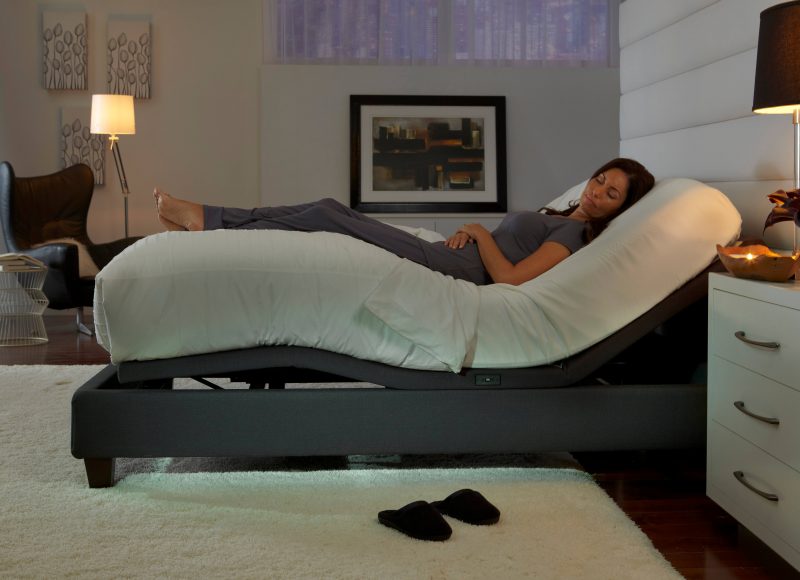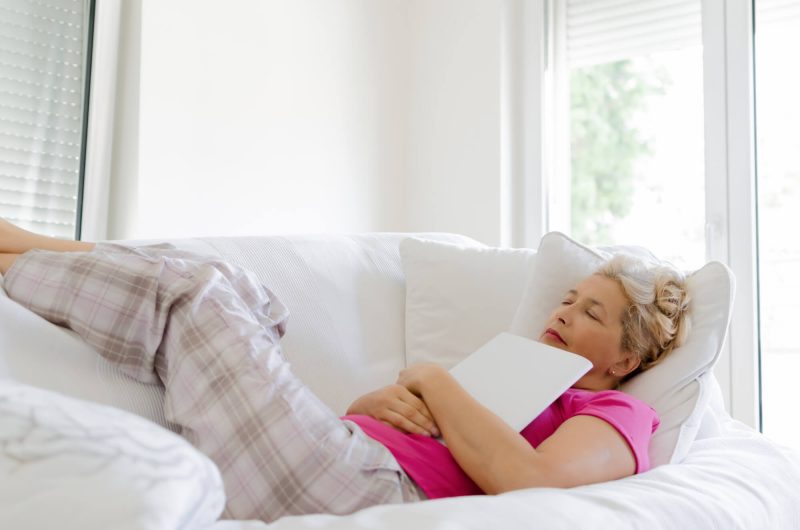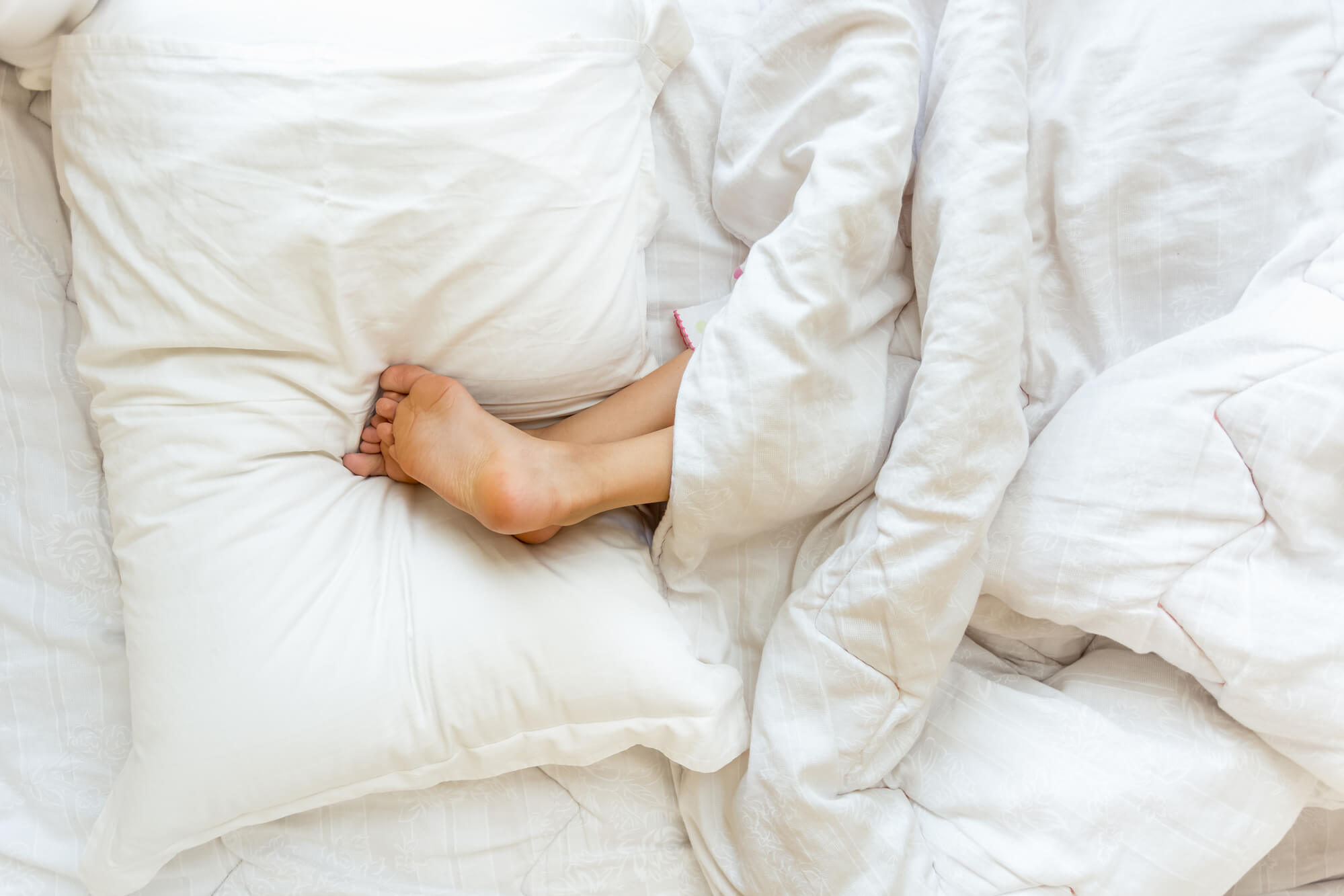Blog
9 Benefits Of Sleeping With Your Legs Elevated
Great sleep has a tremendous effect on your daily mood and overall health. Days tend to flow better if you got the necessary length of slumber the night before! According to the Mayo Clinic, the right amount of sleep for adults is between 7 and 9 hours. But sometimes getting the correct amount of sleep isn’t enough.
Doctor Eric J Olson, M.D, a Sleep Disorder Specialist at the Mayo Clinic, argues that the “quality of your sleep is just as important as the quantity.” Limiting cell phone use before bed, sleeping in a dark room, and sleeping on a natural latex mattress (that’s personalized for you) have all been shown to raise sleep quality, but sometimes picking this low-hanging fruit is only half of the battle.
In order to improve sleep quality on a consistent basis like Olsen suggests, some sleepers with specific physical conditions may want to consider alternative sleep positions that give their body a different shape than their current position of choice…
But don’t worry, this positional change isn’t always as complicated as a back sleeper becoming a side sleeper or vice-versa. For many folks, a simple solution to their sleep woes is using an adjustable bed or pillow to elevate legs in bed.
Best Mattresses for Sleeping with Your Feet Elevated
Keep in mind as you read this article that only certain types of mattresses will work with adjustable bases(foundations) if you decide to move on from using pillows to elevate your legs. These mattresses work with proper adjustable bed because they are able to bend and flew with the movement of the adjustable base.
- Latex Mattresses
- Latex mattresses are our number one choice. They just have so many benefits when compared to other mattresses.
- Hybrid Latex Mattresses
- Hybrid latex mattresses are a good choice but don’t as much comfort and personalization as an all-latex mattress.
- Memory Foam Mattresses
- Memory foam mattresses are our least favorite option. They sleep hot, trap heat, aren’t very durable, they off-gas and there are made with lots of synthetics and unnatural fabrics.
***Keep in mind that the thickness of the mattress plays a role in the functionality of the mattress working with the adjustable base. Now more on Sleeping with Your Legs Elevated.
Why Sleeping with Legs Up Can Be Good for Your Body

Sleeping with legs elevated (by using a Leggett & Platt adjustable bed base, or any other method) can be just what the doctor ordered, but to be sure you’re doing right by your own body, please contact your doctor to discuss any serious health condition.
The text below is meant as a general overview of the benefits of sleeping with elevated legs. Under no circumstances should it be considered medical advice.
Better Blood Circulation & Overall Health Benefits
Staying hydrated, eliminating smoking, and limiting alcohol consumption are three dietary tricks to improving blood circulation. Studies have found that supplements like green tea, Ginkgo Biloba, and beetroot powder can also have blood flow benefits. But for many, this isn’t enough to give you the optimal flow of blood through your body’s lower half.
Sleeping with elevated legs as a solution for blood flow problems that can be linked back to ancient yoga teachings. The uttanpadasana yoga pose (aka legs up the wall) strengthens core muscles like the abdominals and thighs, but more importantly pulls blood from your legs and lower body, into your organs, and towards the heart. Pulling deoxygenated blood from the feet, legs, and lower body towards the heart more easily reoxygenates the blood before it is then pushed into back into the body.
You can use the yoga pose mentioned above intermittently throughout the day. But if you’re looking for night time relief, using a pillow for elevating legs (or an adjustable base) has a similar effect for circulation of the feet and legs which may be helpful for you! Though you won’t have your legs raised as high as you would while doing the uttanpadasana position, a slight incline uses gravity to bring stagnant blood from your feet, to your knees, to your upper legs, back to the core ofthe body for filtering and recirculation.
Reduces Inflammation In Your Lower Body
The pros and cons of sleeping with legs elevated can be debated, but it’s extremely hard to disagree with the medical benefits of reducing inflammation.
Inflammation happens when the body is injured or suffers significant changes from its normal state. Inflammatory markers in one’s blood, such as C-reactive protein, erythrocyte sedimentation rate, and procalcitonin are released when there is inflammation present. And as a result, these markers can be used to measure acute inflammation.
Medical specifics aside, we can all agree that reducing inflammation is good! That’s why many people who suffer chronic inflammation make sure to avoid highly inflammatory foods such as processed meat, refined sugars, alcohol, and artificial trans fats. Taking it one step further, adding foods and supplements like turmeric, berries, and avocados can be helpful in keeping inflammation at bay.
Elevation of the legs during sleep, by means of an adjustable bed or otherwise, could have a positive effect on inflammation too! Though the medical studies are behind the times in supporting these claims and more information is needed, reducing blood pooling in your legs and feet leads to a reduction in pressure and swelling. That’s why many folks find that sleeping with legs elevated at night has a positive effect on lower body inflammation and back pain.
Relieves Chronic Back Pain Such As Sciatica Or Herniated Discs
Inflammation of the sciatic nerve can be blamed for many upper back, lower back, and leg pain problems. This important, very long nerve runs down your entire back, through your waist, and completely down the legs.
According to the Cleveland Clinic, sciatica is “nerve pain from an injury or irritation to the sciatic nerve, which originates in your buttock/gluteal area.” If you have numbness or frequent tingling in your feet and legs, then sciatica could be the cause. The Cleveland Clinic states that sciatica can be caused by a herniated disc where it becomes an issue suddenly, or by arthritis when the back and leg pain becomes more intense over time.
Though you can’t solve sciatic nerve pain by altering your sleep position overnight, you can relive some of the suffering by raising your legs above your upper body when laying on your back. This can be done actively while watching television, or more passively while sleeping. Using a zero gravity position on an adjustable bed can also provide some pain relief.
Helps Reduce Peripheral Edema Pain In The Legs & Feet
According to the United States National Institutes of Health (NIH), “…edema arises when part of the body becomes swollen because fluid gathers in the tissue.” The NIH goes on to state that this condition “most commonly affects the arms and legs” and in those cases, “is called peripheral edema.”
Peripheral edema can be a serious condition because the poor circulation is often the sign of much larger vascular, liver, or kidney issues. Your problems will not simply be solved by elevated legs, but there could be benefits of sleeping with the legs and feet raised up because it is a way to keep the leg swelling at lower levels. Many people with excess fluid in their lower legs enjoy kicking their feet up at night on the couch or while in bed as a way to give their legs a break. This is especially true for many people who stand on their feet all day for work.
Suppress Symptoms of Varicose Veins (Spider Veins)
Unlike some of the other conditions listed on this page, varicose veins are not as significant of a threat to your long-term health. Though the condition is considered unsightly by many, the truth is that other leg swelling pains such as edema or DVT are more and more concerning to doctors.
According to Johns Hopkins Medicine, varicose veins are “enlarged, twisted veins that can happen anywhere in the body, but more common in the legs.” You may have heard of these twisted veins referred to as “spider veins” because that is what the mild form of varicose veins is called.
Where DVT affects deep inside the veins, varicose veins, according to Johns Hopkins, present more of an issue closer to the skin. This is why leg veins affected by DVT are a greater risk factor to your overall health.
Both Johns Hopkins and many other trusted medical sources suggest keeping legs elevated a few times per day as a possible treatment for varicose leg veins where the swelling is milder to moderate. Elevating legs during sleep time can also be done by those who want added relief.
Potential Prevention of Deep Vein Thrombosis
Deep vein thrombosis, often called DVT, happens when blood clots form deep inside your limbs. The more common areas for this to happen are in arms, hands, legs, and feet. Symptoms can often include, but are not limited to, cramping and sore pains, bright red or discolored skin in the infected limb, and a feeling of warmth in the limb where the DVT has occurred. Unlike varicose veins, DVT should not be taken lightly!
Deep vein thrombosis is relevant to elevated legs during sleep because one of the more common causes of the condition is when legs are stationary for too long. When someone is bedridden (many times in a hospital bed) for a lengthy period of time, their legs and feet may not get enough movement to stimulate blood flow. These circumstances are common ground for DVT to become an issue.
Adjustable beds, or even an elevated leg pillow, can help with deep vein thrombosis prevention because these methods of leg elevation aid blood circulation and swelling reduction. Many patients who already have DVT report that, at the very least, lifting legs up above the heart helps relieve some pain.
Decreases Painful Swollen Legs And Feet
There are many serious causes for swelling of the feet and legs, and this article mentions a few of them. But unlike those medical conditions listed in the sections above, swollen feet and legs (without any underlying problems attached) is something every one of us can experience from time to time…
According to Harvard Medical School, “ When you are on your feet a lot, gravity pulls blood into the veins of your legs, and some of the water in the blood enters the tissues of your legs and feet, causing them to swell.”
In order to remove water that’s in the blood of your leg and foot tissues, you can elevate your legs. By lifting your legs up while sleeping or (periodically throughout the day), you’re using gravitational forces to help your body remove this water in the blood from your leg and foot tissues. Utilizing gravity, as we’ll discuss below, saves your heart from working as hard.
If you stand all day for work, sitting down can make your legs feel much better. But if you want to take it one step further, make sure you’re getting nightly rest while your feet are raised up with the assistance of an adjustable bed frame.
Reduces Strain On Heart Muscles
As discussed in the sections on better blood circulation and inflammation reduction, elevating your legs while sleeping or incrementally throughout the day helps pull older deoxygenated blood towards the heart where the blood, to some extent, is cleaned and then released back into the bloodstream. While it may seem counterintuitive to think about this process reducing strain on heart muscles, there is definitely science behind the claim…
When blood is pulled towards the heart by means of elevated legs or otherwise, this is less work for the heart. Instead of the heart pumping harder to bring the blood back to it, gravity does much of the work. Less workload for the heart means less strain and improved cardiovascular function, which is why science supports frequent leg elevation as one way to reduce strain on your heart and vascular system.
Possible Improvement Of Spinal Alignment
If you think you may need to improve your spine alignment, then we suggest contacting a trusted local chiropractor by phone or email to schedule a consultation…
But in the meantime, one free method that may be worth trying is to elevate your lower legs on a few pillows while resting in bed.
Keeping your legs slightly elevated while laying on your back (or even while sitting) helps you keep good posture and can take pressure off the lower back.
In addition to relieving lower back pain in the short term, this neutral spine position (if used over time) may help get your spine into better alignment when compared to being curled up in a ball on your side sleeping.
Best Ways To Elevate Your Legs While Sleeping

When you exclude paying someone to hold your legs up all night, there are really only two logical ways to keep your legs elevated while you sleep at night; a stack of pillows, or an adjustable bed.
Leg Elevation Pillow Strategy
If you want a cheap way to prop up your legs in bed, then a pillow is going to be the most cost effective strategy, however, be warned that it is not as functional as the method we’ll list below.
To raise your legs above your heart while sleeping, using one pillow alone is often not good enough. You’ll want to use 2 if not 3 pillows in order to raise your legs to a height above the level of your heart.
Raising your legs above your heart is the recommended height for more serious pain relief, but is not always necessary for less problematic conditions. You can enjoy the benefits of sleeping with the legs elevated by using just one pillow first, which will raise them a small amount. Give this a try to see if it helps you before you start stacking 2, 3, or 400 pillows like you’re constructing a full-fledged tower.
Adjustable Beds for Sleeping With Legs Elevated
If stacking lots of pillows on top of each other feels ridiculous, then fear not! Years and years ago, the only way to lift your legs in bed was the pillow strategy. But fortunately for you, new products have entered the market that not only elevate your lower body with ease, but also bring many other improvements to your lifestyle. We are of course talking about everyone’s favorite bedding product; the adjustable base.
Adjustable beds by Leggett & Platt, Reverie, and other companies have a wide array of features that customers love; including but not limited to:
- Pillow tilt (for raising your neck and head while sleeping)
- Full body massage
- Wall hugging adjustable bed features (on L&P bases)
- Zero gravity sleep positions
- Dual USB charging stations
- Under bed lighting
- The ability to adjust your bed’s position via remote control
Best Adjustable Bed for Elevating Your Legs
As a Leggett & Platt retailer, we may be a little bias, but many online reviewers and experts agree that Leggett & Platt’s S-Cape 2.0 adjustable bed is one of the best adjustable bases out there for not only elevating your legs, but generally as one of the best adjustable beds on the market today.
Is Sleeping With Elevated Legs Worth It?
Sleeping with your lower extremities elevated comes with many benefits and very few downsides. Whether you’re employing this sleep position to help with a problem you already have or to prevent future issues, there is no denying it’s effectiveness. We think elevating your lower body is worthwhile, but the decision is ultimately up to you and your doctor.
